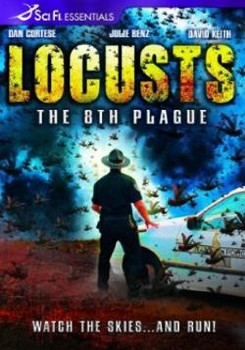The original version of Three Blind Mice from 1609 goes:
Three Blinde Mice,
Three Blinde Mice,
Dame Julian,
Dame Julian,
The Miller and his merry olde Wife
she scrapte her tripe licke thou the knife.
The original version of Three Blind Mice from 1609 goes:
Three Blinde Mice,
Three Blinde Mice,
Dame Julian,
Dame Julian,
The Miller and his merry olde Wife
she scrapte her tripe licke thou the knife.
 The historic snowstorm that dumped two feet of snow on us over the weekend was a great excuse to watch movies. Today’s film review is one I’ve been really excited to see for awhile: Locusts: The Eighth Plague (2005).
The historic snowstorm that dumped two feet of snow on us over the weekend was a great excuse to watch movies. Today’s film review is one I’ve been really excited to see for awhile: Locusts: The Eighth Plague (2005).
One of the reasons I like to watch insect horror films is to gain an understanding of the way humans perceive the insect world. I also just like to watch them. For more insect horror film reviews on this blog, you can search “Reel Bugs.”
The plot, in brief, goes something like this: a handsome, square-jawed entomologist with gel in his hair named Colt Anderson teams up with his fiancée, Vicky Snow, who is (I think) a veterinarian who works for the public health authorities, to stop a swarm of predatory, carnivorous locusts.
These genetically engineered locusts have escaped from a top-secret facility somewhere in Idaho, and they’re the size of TV remotes. The evil corporate scientists bred this flesh-eating strain for vaguely unspecified reasons. The swarm starts attacking people, and bodies pile up. Colt and Vicky must contain the disaster and stop the swarm from splitting, breeding, and taking over ALL OF NORTH AMERICA.
Inexplicably, Colt and Vicky have a great deal of authority over the USDA SWAT-team guys that show up by helicopter and set up a high-tech command center in the center of town. I mean, sure, there’s the overzealous military guy who insists on deploying a sinister government pesticide to stop the menace, but even he defers to Colt and Vicky. Vicky is a stock character of the genre: the hot, 20-something female scientist with an advanced degree. But despite their efforts, the swarm continues to breed and multiply and attack and eat people.
There’s a pretty laughable scene after about fifty people have been eaten alive, where Colt sits by a lake, tossing pebbles contemplatively into the water. Clad in her signature tight camisole and jeans, Vicky puts her arms around him and asks him what’s bothering him. Um, how about the fact that fifty good citizens from Idaho have been reduced to Hamburger Helper? Colt gives an impassioned speech about how man shouldn’t tamper with nature, adding something about global warming.
I think my favorite line, though, is one of Vicky’s. After the swarm has attacked more people, she grabs the phone from an underling in the command center and says, “This is Vicky Snow. I need a list of all the outdoor activities going on today, and I need it now.”
A lot of people get reduced to bloody mush, but the effects are so hokey, you just get the impression that a lot of barbecue sauce was spilled in the making of the film.
I won’t give away the ending, but it involves some scientific gobbledygook nonsense about activating a pheremone lure that the locusts must respond to “because it’s hard wired into their genetic makeup.”
This is a low-budget movie, and the filmmakers definitely borrowed some ideas. There’s a scene where the locusts attack a picnicking family and the young boy only just makes it to the confines of their SUV where he then watches his mom and dad get devoured. He drives away, crashes the car, and then enters a semi-catatonic state because he’s so traumatized by what he has just witnessed.
Well. Practically that exact scene occurred in a previous movie, The Swarm (1978), where bees overpower a family picnic and only the son escapes with his life and he, too, drives away, crashes the car, and enters a semi-catatonic state because he’s so traumatized by what he has just witnessed. And an even earlier movie, Them! (1954), has a little girl who is traumatized by having seen her parents get eaten by giant ants, but it being a 1954 production, the eating happens off-camera.
You know what’s the scariest part? The fact that I knew all that.
You can–cough!–click through to read my previous reviews of The Swarm and Them! if you happen to be a fellow insect horror-film buff.
Both the wife and mother-in-law of Alexander Graham Bell (1847 – 1922), inventor of the telephone, were deaf.
Bubble gum was first developed in 1906, but it was brittle and sticky and didn’t make good bubbles. It was called Blibber-Blubber.
Quite some time ago on this blog, I crowed about a purchase I’d made on ebay. I’d bought some cinchona powder and some quinine. These medicines were used in the olden days to treat malaria. The bottles came from an old pharmacy, which I think was being demolished or something. I thought I would be getting empty bottles (for showing at school visits) but they both came nearly full of powder and pills.
 Doctors don’t prescribe quinine to treat malaria much anymore unless they’re really desperate to help a patient who hasn’t responded to other treatments. Quinine has unpredictable and potentially serious side effects (among them, an unsteady gait and ringing ears). Cinchona bark is the older form; quinine was eventually derived from it. Cinchona was “discovered” by Europeans in the seventeenth century, when some Jesuit priests noticed that Aztec people were drinking a powdered bark mixture that palliated the fever from malaria. For a few centuries, “the bark” was the only successful treatment for malaria.
Doctors don’t prescribe quinine to treat malaria much anymore unless they’re really desperate to help a patient who hasn’t responded to other treatments. Quinine has unpredictable and potentially serious side effects (among them, an unsteady gait and ringing ears). Cinchona bark is the older form; quinine was eventually derived from it. Cinchona was “discovered” by Europeans in the seventeenth century, when some Jesuit priests noticed that Aztec people were drinking a powdered bark mixture that palliated the fever from malaria. For a few centuries, “the bark” was the only successful treatment for malaria.
I was interviewing a specialist in infectious diseases some time ago, and I asked her if it would hurt me to take a tiny taste from my bottle of cinchona powder. I’d read that it’s extremely bitter (British soldiers stationed in India masked the taste of their quinine water with gin and lime juice–and created the gin and tonic) and I wanted to know just how bitter it was. She said most likely it would not hurt me.
The problem with my bottle was that the old cork disintegrated in my fingers. I couldn’t get it out. I gave up, assuming I’d never really know what cinchona tasted like.
But then, look what I found last week at one of my favorite stores in New York:

Amazing, right? Here’s what it looks like:
 It’s meant to be steeped in hot water like tea. But I just tasted a tiny—a really teeny-tiny—crumb–about the size of the one you see in the picture above.
It’s meant to be steeped in hot water like tea. But I just tasted a tiny—a really teeny-tiny—crumb–about the size of the one you see in the picture above.
I’d like to meet someone who’s been able to down a cup of cinchona tea. Maybe they did it on Fear Factor or something.
It’s hard to describe just how dreadful the taste was. I experienced it in several stages. The first stage (wine connoisseurs call it the “mouthfeel,” I think) was just flavorless and unpleasantly hard, like I’d gotten a piece of cork in my mouth. But as the cinchonic bouquet developed, I felt a growing sense of dread. Then the neurons began firing into my brain.
Have you ever picked a dandelion and then touched the milky end of the stem to your tongue? It’s really bitter, right? Imagine tasting something that’s fifteen fifty times worse. Bitter hardly begins to describe it. My brain’s neurons were now lighting up–abort! abort! abort! Spit this out! But then the mouth tells the brain it’s too late, that there’s nothing to spit out. Yet the vile taste remains. All hope drains from one’s soul. I wanted to wipe my tongue with a napkin like Tom Hanks does in Big when he tastes caviar. Instead I took a hasty spoonful of ice cream to expunge the memory.
But I’m glad I finally tried it. I strongly advise you, dear reader, to take my word for it, but if you’re absolutely determined to taste cinchona yourself, you can find it on the second floor of Kalustyan’s, at 28th and Lexington. But don’t say I didn’t warn you.
The first indoor swimming pool opened in London in 1742. It was 43 feet long and available only to wealthy gentlemen.
 You’ve no doubt heard the news—it’s been all over the place these past few days—that the remains of King Richard III (1452 – 1485) have been found underneath a car park in Leicester, England. They’ve been formally identified by archaeologists, bone specialists, and DNA analysts. The skeleton shows some pretty grievous battle wounds. The base of the skull has been hacked off, most likely with a vicious six-foot-long axe-like thing called a halberd. And his body was probably further mutilated after he died; it appears to have been stabbed through the butt. Nice.
You’ve no doubt heard the news—it’s been all over the place these past few days—that the remains of King Richard III (1452 – 1485) have been found underneath a car park in Leicester, England. They’ve been formally identified by archaeologists, bone specialists, and DNA analysts. The skeleton shows some pretty grievous battle wounds. The base of the skull has been hacked off, most likely with a vicious six-foot-long axe-like thing called a halberd. And his body was probably further mutilated after he died; it appears to have been stabbed through the butt. Nice.
The first time I remember paying any attention to this fifteenth century king was in college, when I took a Shakespeare class and we read Richard III. In Shakespeare’s play, Richard is called a “poisonous bunch-backed toad,” and “that foul defacer of God’s handiwork.” And pretty much from then on, I bought into the Tudor propaganda about the guy, that although loyal to his handsome, womanizing older brother, Edward IV while Edward was alive, he almost immediately usurped the crown upon his brother’s death, littering the path to the monarchy with a trail of bodies. Richard, the Tudors reported, was an evil monarch with a hunchback and a withered arm, and he slew his dead brother’s two young sons (the princes in the tower—12-year-old Edward V and his brother Richard) who stood in the way of his throne.
He reigned for just two years before he was killed in the battle of Bosworth in 1485, the last of the Plantagenet kings. After him, Henry Tudor, known as Henry VII, began the long Tudor reign.
 But there are many who doubt the Tudor version of events. Richard III has his own fan club. These doubters believe that Richard was vilified by writers who were on the Tudor payroll, most notably Sir Thomas More (who wrote The Life of Richard III but was only 8 when Richard died) and Shakespeare himself, whose play was published in 1597, a hundred years after Richard’s death.
But there are many who doubt the Tudor version of events. Richard III has his own fan club. These doubters believe that Richard was vilified by writers who were on the Tudor payroll, most notably Sir Thomas More (who wrote The Life of Richard III but was only 8 when Richard died) and Shakespeare himself, whose play was published in 1597, a hundred years after Richard’s death.
The RIII fans claim that at the time it became widely known that Richard’s brother, Edward IV, had previously married, packed that wife off to a convent, and then hitched up with Elizabeth, who was not, therefore, a lawful wife. And that therefore young Edward and his brother were illegitimate and had no claim to the throne. So why would Richard bother having his nephews killed if they posed no threat? (Their bodies were never found, and the henchman said to have killed them didn’t confess until twenty years after their purported death. And we know how persuasive Tudor jailers could be when extracting confessions.)
Josephine Tey (pen name of Elizabeth MacKintosh) was a fiction writer solidly in the RIII fan club. She published a novel in 1949 called The Daughter of Time, in which a bedridden detective examines the contemporary evidence and concludes that Richard was the victim of a Tudor smear campaign. The book lays out a persuasive defense of Richard.
No matter how you feel about him, it’s pretty cool to have the last of the Plantagenet kings trending on Twitter.
The Greek Stoic philosopher Chrysippus (279 BC – c. 206 BC) was said to have died from an excessive bout of laughter.
In 1800, the Mona Lisa hung in Napoleon’s bedroom. (It was moved to the Louvre in 1804.)
In the course of doing image research for an upcoming book, I’ve discovered some incredible photos (most of which I can’t use in my book). Here’s a series taken by a Scottish photographer named William Carrick (1827 – 1878), who lived and worked in St. Petersburg for much of his professional career. Along with his partner, John MacGregor, he took some amazing pictures of everyday Russians. According to the website from the National Galleries of Scotland, Carrick produced many of these images as “cartes de visite” for tourists to buy, in order to earn some extra income.
Have a look (and while you’re looking–do the knife grinder and the tool seller/carpenter look like the same person to you? Or perhaps brothers?):







